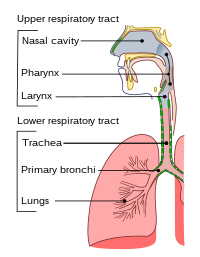
Photo from wikipedia
The repair and functional reconstruction of long-segment tracheal defects is always a great challenge in the clinic. Finding an ideal substitute for tracheal transplantation is the only way to solve… Click to show full abstract
The repair and functional reconstruction of long-segment tracheal defects is always a great challenge in the clinic. Finding an ideal substitute for tracheal transplantation is the only way to solve this problem. The current study proposed a series of novel strategies for constructing a bionic living trachea substitute. For the issue of tubular cartilage support, cartilage sheet technique based on high-density culture of chondrocytes was adopted to avoid the inflammatory reaction triggered by the materials and thus formed mature cartilage-like tissue in autologous goat model. For the issue of epithelialization, the autologous transplantation of oral mucosal epithelium was used to realize mucosa coverage of the constructed trachea lumen. Finally, the flat trapezius fascia flap with double blood supply was separated by microsurgical techniques to achieve stable pre-vascularization of both the regenerated cartilage and the grafted epithelium simultaneously. By integrating the above strategies, the vascularized and epithelialized tracheal substitute with tubular cartilage support was successfully constructed in a goat model. The reconstructed trachea possessed a multiple layer structure of muscle-cartilage-fascia-mucosa comparable to the native trachea, and thus might realize stable survival and long-term airway function maintenance, providing a promising tracheal substitute for the repair and permanent functional reconstruction of long-segment tracheal defects. STATEMENT OF SIGNIFICANCE: The repair of long-segment tracheal defects is always a great challenge in the clinic. Finding an ideal substitute for tracheal transplantation is the only way to solve this problem. In the current study, by technical integration of cartilage regeneration, microsurgery, and oral mucosa transplantation, a complex tracheal substitute with satisfactory vascularization, epithelialization, and tubular cartilage support was successfully constructed in a goat autologous model. The reconstructed trachea substitute possessed a multiple layer structure of muscle-cartilage-fascia-mucosa exactly similar to native trachea, and thus might realize stable survival and long-term airway function maintenance. The current study provides feasible strategies and ideal tracheal substitutes for permanent functional reconstruction of long-segmental trachea defects.
Journal Title: Acta biomaterialia
Year Published: 2019
Link to full text (if available)
Share on Social Media: Sign Up to like & get
recommendations!